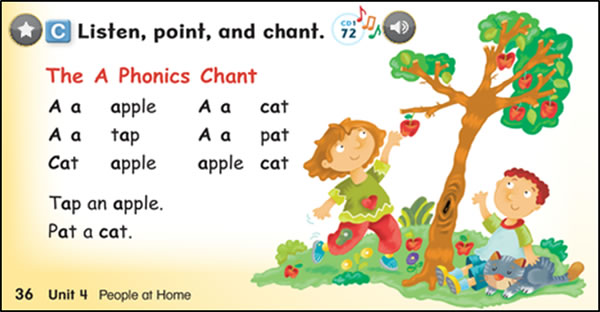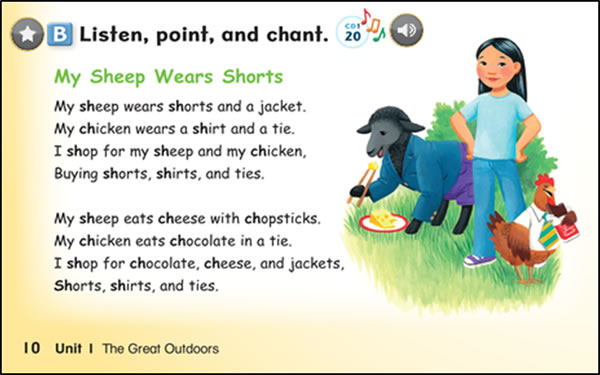Barbara Hoskins Sakamoto, co-author of Let’s Go, looks at how to make the most of songs in the English classroom – even when your students resist singing…
Most of the time, students (and their teachers) enjoy songs and chants, and they’re a staple in young learner classrooms. When students seem reluctant to sing or chant, it’s because they don’t feel confident with the lyrics or melody. You can increase your chances of success by presenting new songs and chants in a way that builds confidence and reduces stress. For example, have the CD playing as students enter the classroom. Have students listen to the song or chant and tell you which words they can hear – you don’t have to focus on the words they can’t yet hear. Songs and chants in Let’s Go always reinforce the language of the lesson, so students will hear words from the conversation, or the new language pattern, or the new phonics words. As they recognize words and phrases and get familiar with the melody or rhythm, they will be building confidence to sing or chant.
Every once in a while, however, you’ll have students who just don’t want to sing or chant. Perhaps your previously enthusiastic singers have become ‘too cool for school’, or perhaps your boys’ voices are starting to change and they feel awkward, or maybe you have a class of older beginners who think they’re too mature for the songs and chants in their books. You can always explain how songs and chants help students remember language, or improve intonation and natural rhythm, but sometimes it’s easier to have some alternative activities that enable you to reap the rewards of using songs and chants without a battle over actually singing or chanting.
Listen and order. Have students copy the lines in the song onto another piece of paper that is cut into strips (so that one line of the song is on one strip of paper), shuffle the strips and give to another student. This gives students practice writing clearly enough so that someone else can read their writing, and practice reading another students’ handwriting. Ask students to read the lyrics and see if they remember the correct order. Play the song for them to confirm. If you want this to be more of a listening and reading challenge, give each pair or group of students a set of lines to the song and have them order them as they listen. If your students aren’t fluent readers, give them word or picture cards to order.

Song taken from Let’s Go 3
Teach writing conventions. Things like punctuation, capitalization and spaces might seem obvious to you, but they are things that have to be learned, especially if your students’ first language uses a written system that’s significantly different than English. Songs and chants tend to be repetitive, which makes them ideal for focusing on conventions. Ask students to count the number of times a specific word appears on the page, and then ask them how they know how to identify where words begin and end (spaces between words). Most songs and chants in Let’s Go include questions and answers, so you can ask students to focus on the way punctuation conveys meaning (just as the voice rising or falling in a question or answer can convey meaning).

Song taken from Let’s Go 1
Use chants and songs as models and inspiration. Have students create their own lyrics based on the original – it takes skill (and a focus on syllables) to figure out how to substitute words and maintain rhythm, but it doesn’t require a great command of language. One of my classes created their own ‘Short A chant’ after playing with words that rhymed with cat during our phonics lesson. I wrote the chant down for them, and was surprised when they asked me to tape the written lyrics on the wall as a prompt during recording. It was the first bit of language they’d ever read independently.

Song taken from Let’s Go 4
Use the songs as poetry and encourage dramatic interpretation. Even the coolest student can get into doing something that is intended for laughs from the beginning (as opposed to accidentally looking foolish). Let groups choose one of the songs and chants in their book and create a music video version where they plan actions and lip sync along with the CD. This can be especially fun when it’s done as an activity at the end of a book, and students can browse through all the songs and chants they’ve done during the year. With an audio CD at the back of the student book, it’s easy for students to listen in order to choose the song or chant for their project. If you let them record their projects, you’ll be amazed at how many times your non-singing students will rehearse in order to match their mouth movements to the audio.
I’ve learned a lot about using songs and chants in language class from Carolyn Graham and it’s been a thrill to work with her for over 20 years on Let’s Go. If you’ve never had a chance to see her present in person, I hope you’ll take a look at her video tips. You can find links to them on our Let’s Share page.
Visit Let’s Share for more videos, blogs and upcoming events by our Let’s Go authors.


[…] Well, if this ever happened to you and you wonder what to do, read on at this link […]